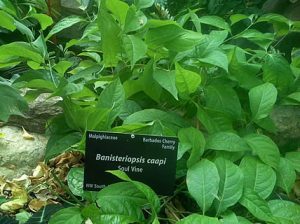By John Summerly
Guest writer for Wake Up World
The Banisteriopsis caapi plant, also known as ayahuasca, caapi or yaje, is a South American jungle vine used to prepare a decoction with a long history of entheogenic uses as a medicine and “plant teacher” among the indigenous peoples of the Amazon Rainforest. It has unique properties found to treat Parkinson’s disease and other neurogenerative disorders.
B.caapi contains harmine, harmaline, and tetrahydroharmine, all of which are both beta-carboline harmala alkaloids and Monoamine oxidase inhibitors (MAOIs). The MAOIs in B. caapi allow the primary psychoactive compound, DMT (which is introduced from the other primary ingredient in ayahausca, the Psychotria viridis plant), to be orally active.
The name ayahuasca means “vine of the soul” and the shamans of the indigenous western Amazonian tribes use the plant in religious and healing ceremonies. In addition to its hallucinogenic properties, caapi is used for its healing properties as a purgative, effectively cleansing the body of parasites and helping the digestive tract.
[pro_ad_display_adzone id=”110028″]
Harmala alkaloids are short term yet powerful MAOIs which render tryptamines orally active by temporarily reducing levels of monoamine oxidase in the body which otherwise rapidly destroys them. Their effects are more powerful and less toxic than pharmaceutical SSRIs since they do not lead to suicidal tendencies and other side effects which detrimentally affect human behavior.
The principal ayahuasca compounds have a common indole structure which, through several mechanisms, influences certain functions of the central nervous system (CNS). The relevant factor is the biochemical similarity of these compounds to the neurotransmitter serotonin (5-HT). The harmala alkaloids in ayahuasca, primarily harmine and tetrahydroharmine, reversibly inhibit the neuronal enzyme monoamine oxidase (MAO).
This allows DMT to be active when ingested orally. It also facilitates accumulation of biogenic amines, such as 5-HT, which are normally metabolized by monoamine oxidase enzymes. DMT is a naturally-occurring biochemical substance secreted by the human body in the pineal gland. It occurs in hundreds of plant species worldwide. It can produce very powerful visionary effects when smoked in its pure form or taken orally in Ayahuasca.
The Ayahuasca Experience
People who have consumed ayahuasca report having spiritual revelations regarding their purpose on earth, the true nature of the universe as well as deep insight into how to be the best person they possibly can. This is viewed by many as a spiritual awakening and what is often described as a rebirth. In addition it is often reported that individuals can gain access to higher spiritual dimensions and make contact with various spiritual or extra dimensional beings who can act as guides or healers.
Wild cats including Jaguars looking for a high will seek out the roots of the caapi plant and gnaw on them until they start to hallucinate. In fact, some scientists believe that humans learned how to use the root by observing the jaguars hallucinate after consuming the plant.
It is incorrect, however, to characterize the Ayahuasca experience as merely an oral DMT experience activated by a beta carboline MAO inhibitor. The holistic processes at work are far more complex and it is unquestionably the ayahuasca vine which fuels the transformative power and profound teaching of the Ayahuasca experience.
It is nearly always said that people experience profound positive changes in their life subsequent to consuming ayahuasca and it is often viewed as one of the most effective tools of enlightenment. Vomiting can follow ayahuasca ingestion; this purging is considered by many shamans and experienced users of ayahuasca to be an essential part of the experience as it represents the release of negative energy and emotions built up over the course of one’s life. There are many reports of miraculous physical as well as emotional and spiritual healing resulting from the use of ayahuasca.
A Natural Healer of The Mind and Spirit
A study in the Journal of Ethnopharmacology found an additional basis to the existing claims of Banisteriopsis caapi stem extract for the treatment of Parkinsonism, including other neurodegenerative disorders.
At least 42 indigenous names for this preparation are known. It is remarkable and significant that at least 72 different indigenous tribes of Amazonia, however widely separated by distance, language, and cultural differences, all manifested a detailed common knowledge of ayahuasca and its use for medicinal and spiritual use.
Both the plant and the medicine prepared from it are called ‘ayahuasca’ in most of the Peruvian Amazon. However, many distinguish the ayahuasca vine (Banisteriopsis caapi) from the medicinal brew (ayahuasca combined with a companion plant such as chacruna).
Accessiblity and Legality
Ayahuasca has also stirred debate regarding intellectual property protection of traditional knowledge. In 1986 the US Patent and Trademarks Office allowed the granting of a patent on the ayahuasca vine B. Caapi. It allowed this patent based on the assumption that ayahuasca’s properties had not been previously described in writing. Several public interest groups, including the Coordinating Body of Indigenous Organizations of the Amazon Basin (COICA) and the Coalition for Amazonian Peoples and Their Environment (Amazon Coalition) objected. In 1999 they brought a legal challenge to this patent which had granted a private US citizen “ownership” of the knowledge of a plant that is well-known and sacred to many indigenous peoples of the Amazon, and used by them in religious and healing ceremonies.
In the United States, caapi is not specifically regulated. In Australia, the harmala alkaloids are scheduled substances, including Harmine and harmaline, but the living vine, or other source plants are not in most states. On the State of Queensland as of March 2008 this distinction is now uncertain. In all states the dried herb may or may not be considered a scheduled substance, dependent on court rulings. In Canada, harmala is listed under the Controlled Drugs and Substances Act as a schedule III substance. The vine is also considered a controlled substance as it contains harmaline which the law states anything containing a controlled substance will be treated the same.
Article Sources:
Recommended articles by John Summerly:
- Constantly Tired? Here are 12 Herbs to Increase Energy and Vitality
- Apple Cider Vinegar – One Of The Most Powerful Health Tonics In Your Kitchen
- Herbal Tea Has Rare Ability to Kill Cancer Cells Without Damaging Other Cells
- 20 Domestic Uses For Coca Cola… Proof That Coke Does Not Belong In The Human Body
- 36 Foods That Help Detox and Cleanse Your Entire Body
- South American Vine Treats Neurogenerative Disorders, Stronger Than Antidepressants
About the author:
John Summerly is nutritionist, herbologist, and homeopathic practitioner. He is a leader in the natural health community and consults athletes, executives and most of all parents of children on the benefits of complementary therapies for health and prevention.
This article reproduced with the permission by preventdisease.com
[pro_ad_display_adzone id=”110027″]







